Health and Wellbeing Report: Dementia as a Priority in Australia
VerifiedAdded on 2022/09/14
|9
|2346
|84
Report
AI Summary
This report focuses on dementia as a significant health priority in Australia, emphasizing its profound impact on individuals, families, and the healthcare system. It begins with a definition of dementia and its relevance, highlighting its prevalence and the economic, social, and health dimensions of the condition. The report delves into key debates and issues surrounding dementia, including self-actualization, technological interventions, and clinical management. It also explores the risk factors and social determinants of health associated with dementia, such as midlife hypertension and physical inactivity, and discusses the importance of wellbeing elements in relation to dementia. The target group, primarily the elderly, is identified, along with health promotion approaches and strategies to address the disease, such as managing chronic conditions and promoting lifestyle changes. The report justifies dementia as a health priority in Australia through a critical analysis of the situation, emphasizing the need for screening and further identification of patients. The conclusion underscores the severity of dementia, the importance of care for the elderly, and the need for education and training programs to guide healthcare policies.
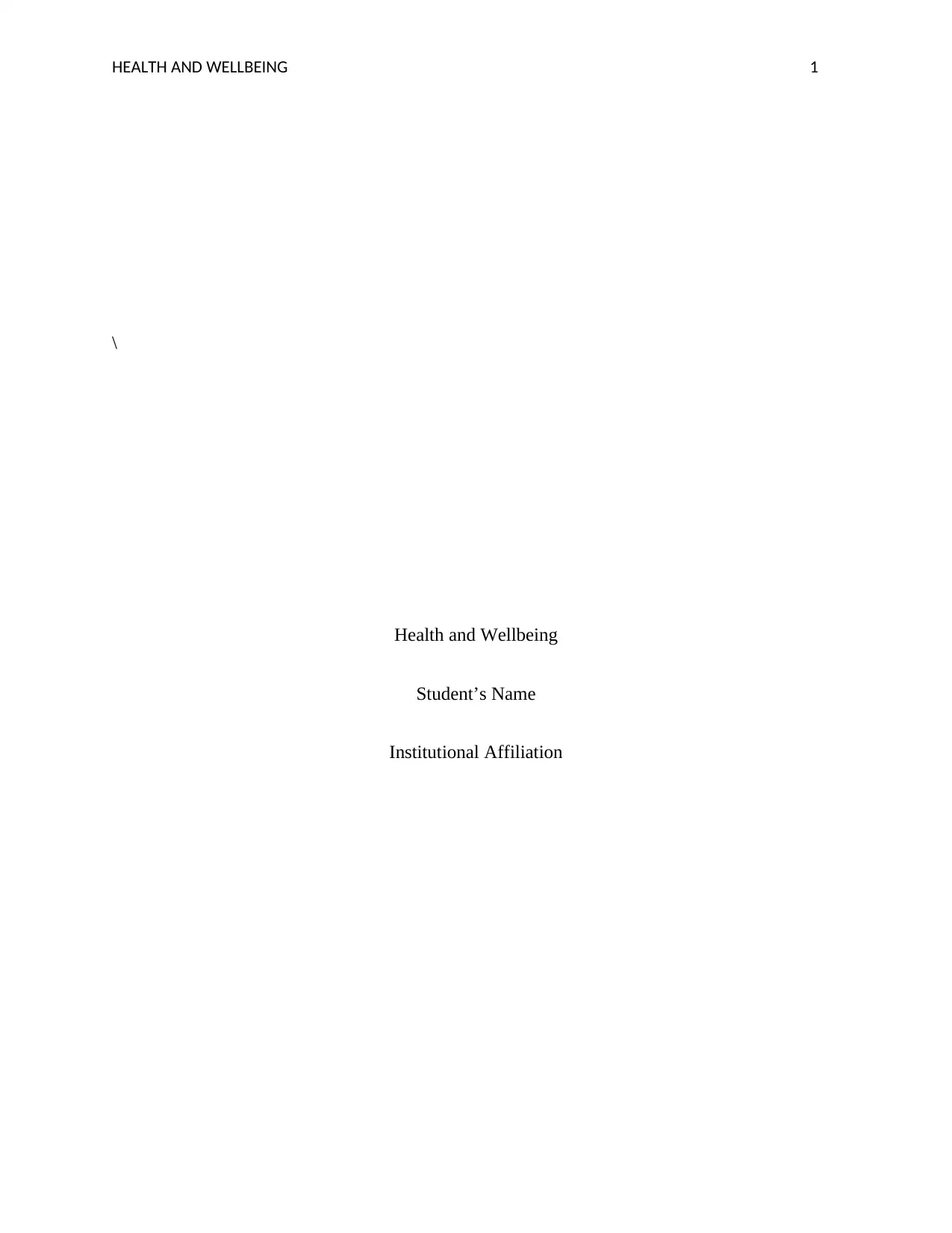
HEALTH AND WELLBEING 1
\
Health and Wellbeing
Student’s Name
Institutional Affiliation
\
Health and Wellbeing
Student’s Name
Institutional Affiliation
Paraphrase This Document
Need a fresh take? Get an instant paraphrase of this document with our AI Paraphraser
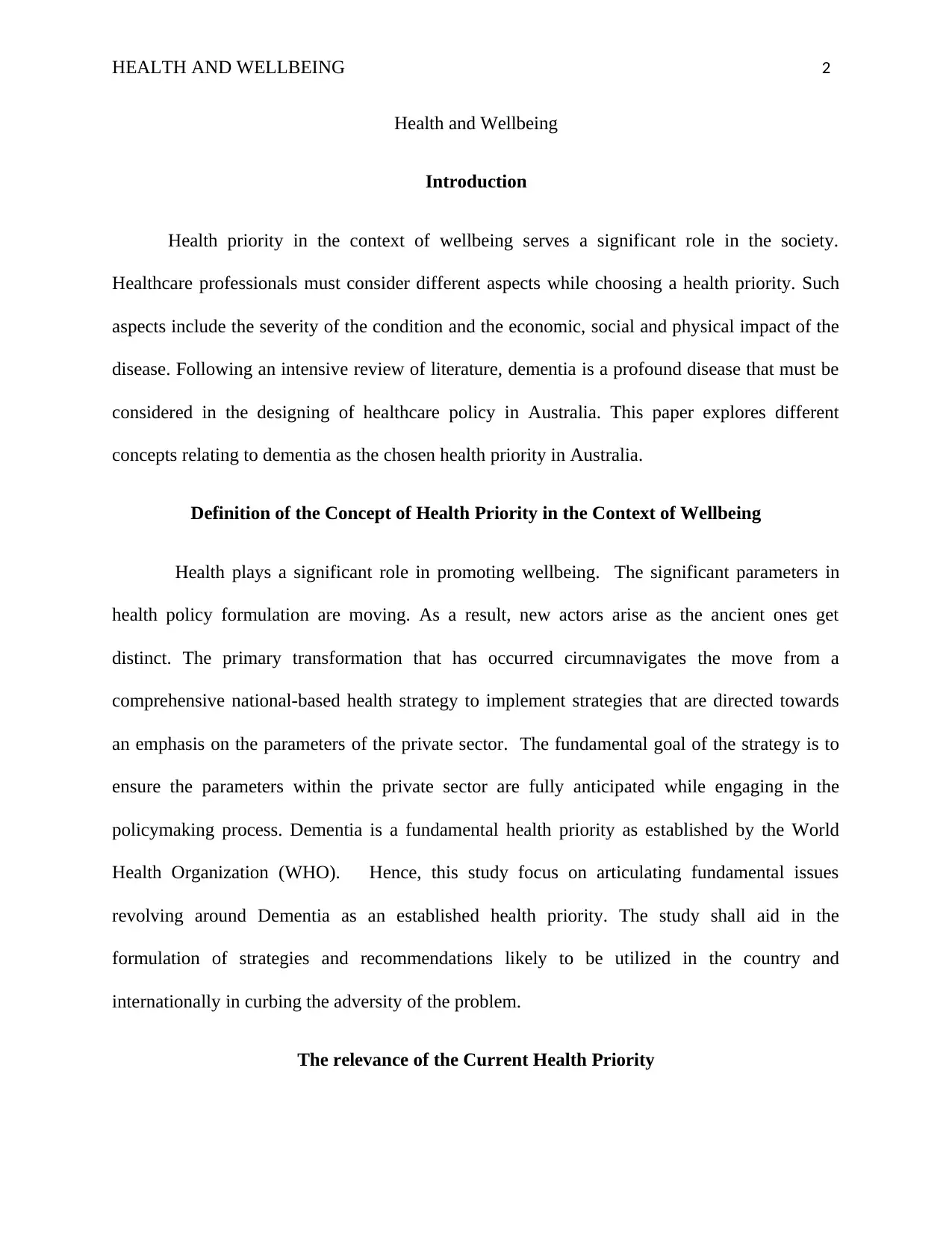
HEALTH AND WELLBEING 2
Health and Wellbeing
Introduction
Health priority in the context of wellbeing serves a significant role in the society.
Healthcare professionals must consider different aspects while choosing a health priority. Such
aspects include the severity of the condition and the economic, social and physical impact of the
disease. Following an intensive review of literature, dementia is a profound disease that must be
considered in the designing of healthcare policy in Australia. This paper explores different
concepts relating to dementia as the chosen health priority in Australia.
Definition of the Concept of Health Priority in the Context of Wellbeing
Health plays a significant role in promoting wellbeing. The significant parameters in
health policy formulation are moving. As a result, new actors arise as the ancient ones get
distinct. The primary transformation that has occurred circumnavigates the move from a
comprehensive national-based health strategy to implement strategies that are directed towards
an emphasis on the parameters of the private sector. The fundamental goal of the strategy is to
ensure the parameters within the private sector are fully anticipated while engaging in the
policymaking process. Dementia is a fundamental health priority as established by the World
Health Organization (WHO). Hence, this study focus on articulating fundamental issues
revolving around Dementia as an established health priority. The study shall aid in the
formulation of strategies and recommendations likely to be utilized in the country and
internationally in curbing the adversity of the problem.
The relevance of the Current Health Priority
Health and Wellbeing
Introduction
Health priority in the context of wellbeing serves a significant role in the society.
Healthcare professionals must consider different aspects while choosing a health priority. Such
aspects include the severity of the condition and the economic, social and physical impact of the
disease. Following an intensive review of literature, dementia is a profound disease that must be
considered in the designing of healthcare policy in Australia. This paper explores different
concepts relating to dementia as the chosen health priority in Australia.
Definition of the Concept of Health Priority in the Context of Wellbeing
Health plays a significant role in promoting wellbeing. The significant parameters in
health policy formulation are moving. As a result, new actors arise as the ancient ones get
distinct. The primary transformation that has occurred circumnavigates the move from a
comprehensive national-based health strategy to implement strategies that are directed towards
an emphasis on the parameters of the private sector. The fundamental goal of the strategy is to
ensure the parameters within the private sector are fully anticipated while engaging in the
policymaking process. Dementia is a fundamental health priority as established by the World
Health Organization (WHO). Hence, this study focus on articulating fundamental issues
revolving around Dementia as an established health priority. The study shall aid in the
formulation of strategies and recommendations likely to be utilized in the country and
internationally in curbing the adversity of the problem.
The relevance of the Current Health Priority
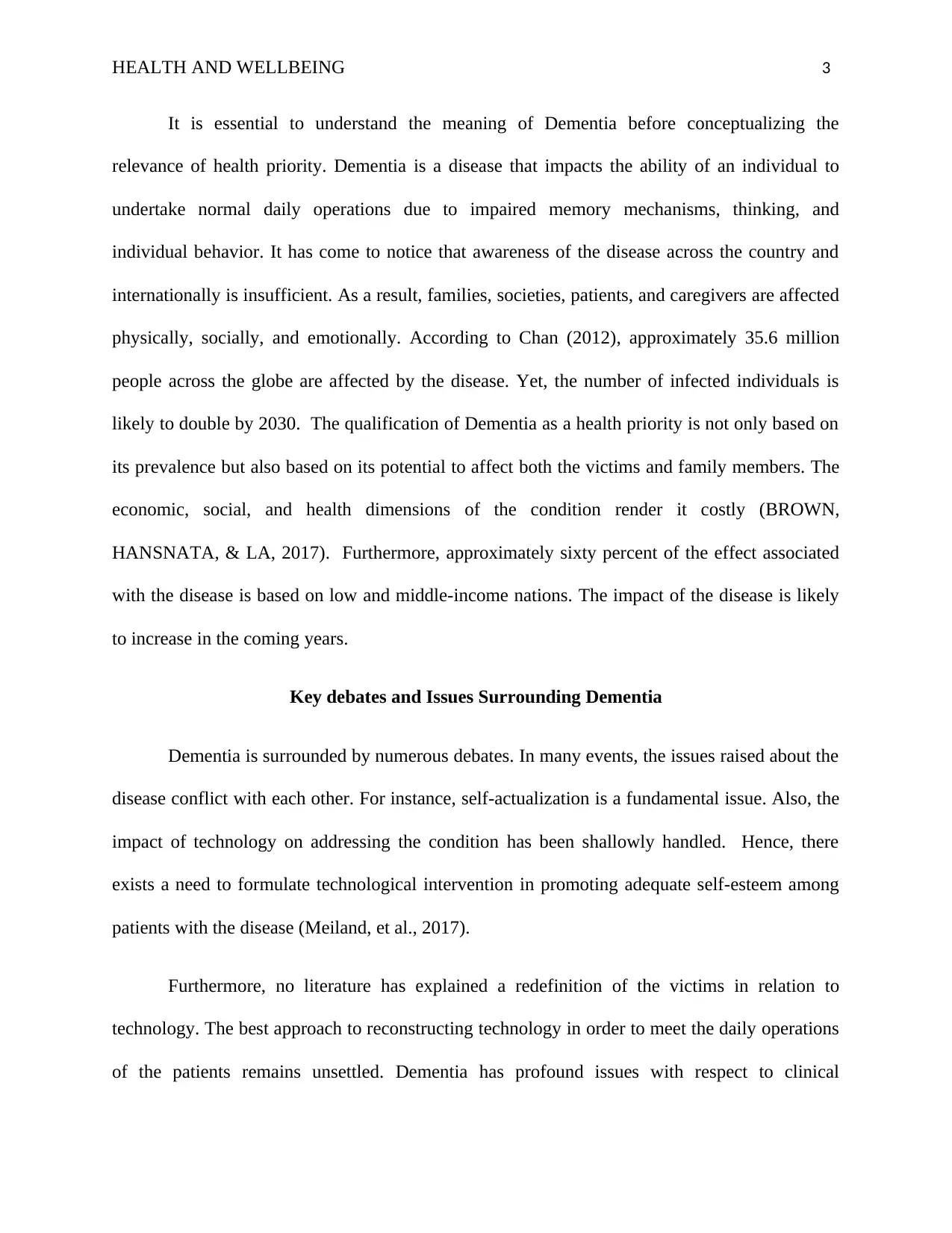
HEALTH AND WELLBEING 3
It is essential to understand the meaning of Dementia before conceptualizing the
relevance of health priority. Dementia is a disease that impacts the ability of an individual to
undertake normal daily operations due to impaired memory mechanisms, thinking, and
individual behavior. It has come to notice that awareness of the disease across the country and
internationally is insufficient. As a result, families, societies, patients, and caregivers are affected
physically, socially, and emotionally. According to Chan (2012), approximately 35.6 million
people across the globe are affected by the disease. Yet, the number of infected individuals is
likely to double by 2030. The qualification of Dementia as a health priority is not only based on
its prevalence but also based on its potential to affect both the victims and family members. The
economic, social, and health dimensions of the condition render it costly (BROWN,
HANSNATA, & LA, 2017). Furthermore, approximately sixty percent of the effect associated
with the disease is based on low and middle-income nations. The impact of the disease is likely
to increase in the coming years.
Key debates and Issues Surrounding Dementia
Dementia is surrounded by numerous debates. In many events, the issues raised about the
disease conflict with each other. For instance, self-actualization is a fundamental issue. Also, the
impact of technology on addressing the condition has been shallowly handled. Hence, there
exists a need to formulate technological intervention in promoting adequate self-esteem among
patients with the disease (Meiland, et al., 2017).
Furthermore, no literature has explained a redefinition of the victims in relation to
technology. The best approach to reconstructing technology in order to meet the daily operations
of the patients remains unsettled. Dementia has profound issues with respect to clinical
It is essential to understand the meaning of Dementia before conceptualizing the
relevance of health priority. Dementia is a disease that impacts the ability of an individual to
undertake normal daily operations due to impaired memory mechanisms, thinking, and
individual behavior. It has come to notice that awareness of the disease across the country and
internationally is insufficient. As a result, families, societies, patients, and caregivers are affected
physically, socially, and emotionally. According to Chan (2012), approximately 35.6 million
people across the globe are affected by the disease. Yet, the number of infected individuals is
likely to double by 2030. The qualification of Dementia as a health priority is not only based on
its prevalence but also based on its potential to affect both the victims and family members. The
economic, social, and health dimensions of the condition render it costly (BROWN,
HANSNATA, & LA, 2017). Furthermore, approximately sixty percent of the effect associated
with the disease is based on low and middle-income nations. The impact of the disease is likely
to increase in the coming years.
Key debates and Issues Surrounding Dementia
Dementia is surrounded by numerous debates. In many events, the issues raised about the
disease conflict with each other. For instance, self-actualization is a fundamental issue. Also, the
impact of technology on addressing the condition has been shallowly handled. Hence, there
exists a need to formulate technological intervention in promoting adequate self-esteem among
patients with the disease (Meiland, et al., 2017).
Furthermore, no literature has explained a redefinition of the victims in relation to
technology. The best approach to reconstructing technology in order to meet the daily operations
of the patients remains unsettled. Dementia has profound issues with respect to clinical
⊘ This is a preview!⊘
Do you want full access?
Subscribe today to unlock all pages.

Trusted by 1+ million students worldwide
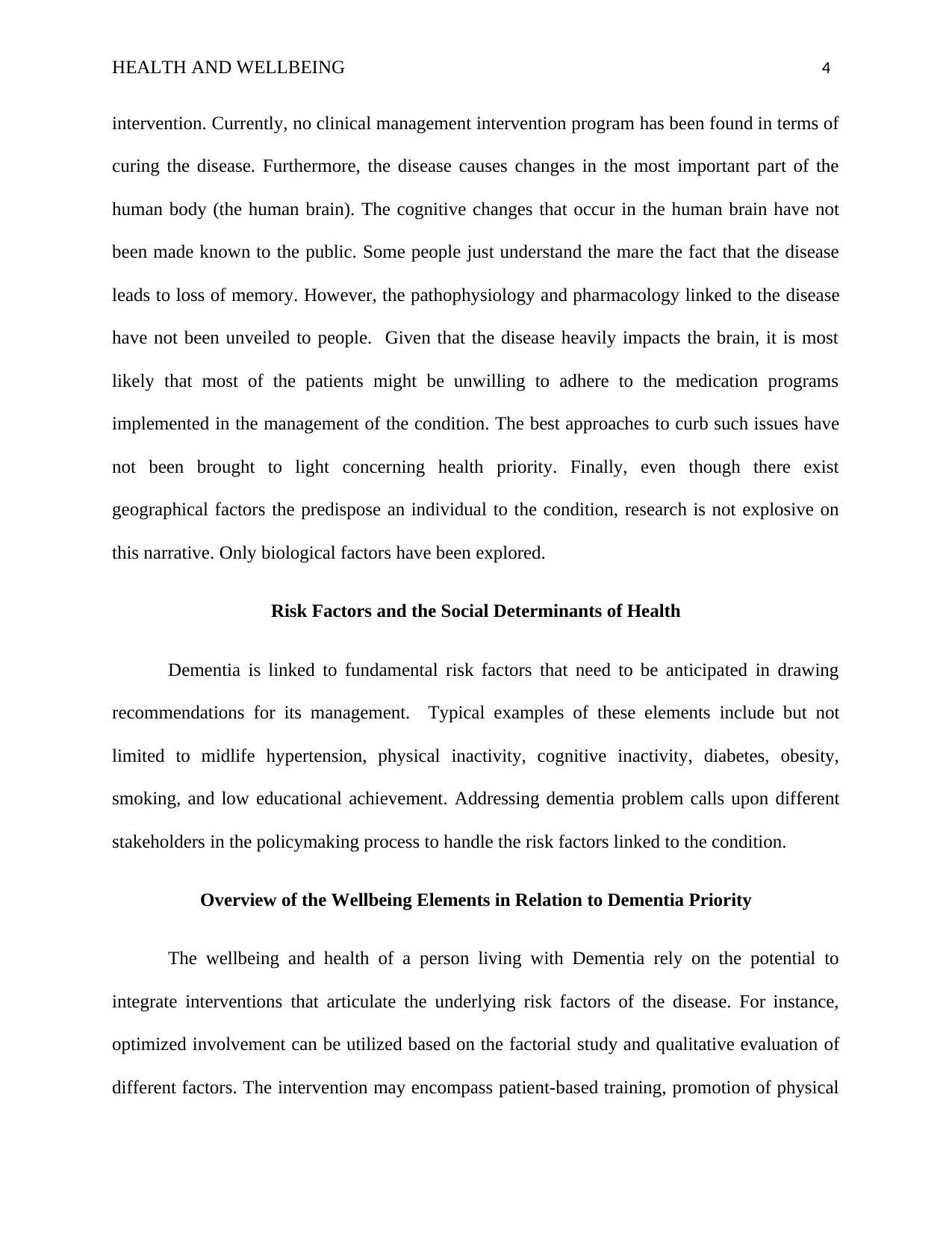
HEALTH AND WELLBEING 4
intervention. Currently, no clinical management intervention program has been found in terms of
curing the disease. Furthermore, the disease causes changes in the most important part of the
human body (the human brain). The cognitive changes that occur in the human brain have not
been made known to the public. Some people just understand the mare the fact that the disease
leads to loss of memory. However, the pathophysiology and pharmacology linked to the disease
have not been unveiled to people. Given that the disease heavily impacts the brain, it is most
likely that most of the patients might be unwilling to adhere to the medication programs
implemented in the management of the condition. The best approaches to curb such issues have
not been brought to light concerning health priority. Finally, even though there exist
geographical factors the predispose an individual to the condition, research is not explosive on
this narrative. Only biological factors have been explored.
Risk Factors and the Social Determinants of Health
Dementia is linked to fundamental risk factors that need to be anticipated in drawing
recommendations for its management. Typical examples of these elements include but not
limited to midlife hypertension, physical inactivity, cognitive inactivity, diabetes, obesity,
smoking, and low educational achievement. Addressing dementia problem calls upon different
stakeholders in the policymaking process to handle the risk factors linked to the condition.
Overview of the Wellbeing Elements in Relation to Dementia Priority
The wellbeing and health of a person living with Dementia rely on the potential to
integrate interventions that articulate the underlying risk factors of the disease. For instance,
optimized involvement can be utilized based on the factorial study and qualitative evaluation of
different factors. The intervention may encompass patient-based training, promotion of physical
intervention. Currently, no clinical management intervention program has been found in terms of
curing the disease. Furthermore, the disease causes changes in the most important part of the
human body (the human brain). The cognitive changes that occur in the human brain have not
been made known to the public. Some people just understand the mare the fact that the disease
leads to loss of memory. However, the pathophysiology and pharmacology linked to the disease
have not been unveiled to people. Given that the disease heavily impacts the brain, it is most
likely that most of the patients might be unwilling to adhere to the medication programs
implemented in the management of the condition. The best approaches to curb such issues have
not been brought to light concerning health priority. Finally, even though there exist
geographical factors the predispose an individual to the condition, research is not explosive on
this narrative. Only biological factors have been explored.
Risk Factors and the Social Determinants of Health
Dementia is linked to fundamental risk factors that need to be anticipated in drawing
recommendations for its management. Typical examples of these elements include but not
limited to midlife hypertension, physical inactivity, cognitive inactivity, diabetes, obesity,
smoking, and low educational achievement. Addressing dementia problem calls upon different
stakeholders in the policymaking process to handle the risk factors linked to the condition.
Overview of the Wellbeing Elements in Relation to Dementia Priority
The wellbeing and health of a person living with Dementia rely on the potential to
integrate interventions that articulate the underlying risk factors of the disease. For instance,
optimized involvement can be utilized based on the factorial study and qualitative evaluation of
different factors. The intervention may encompass patient-based training, promotion of physical
Paraphrase This Document
Need a fresh take? Get an instant paraphrase of this document with our AI Paraphraser
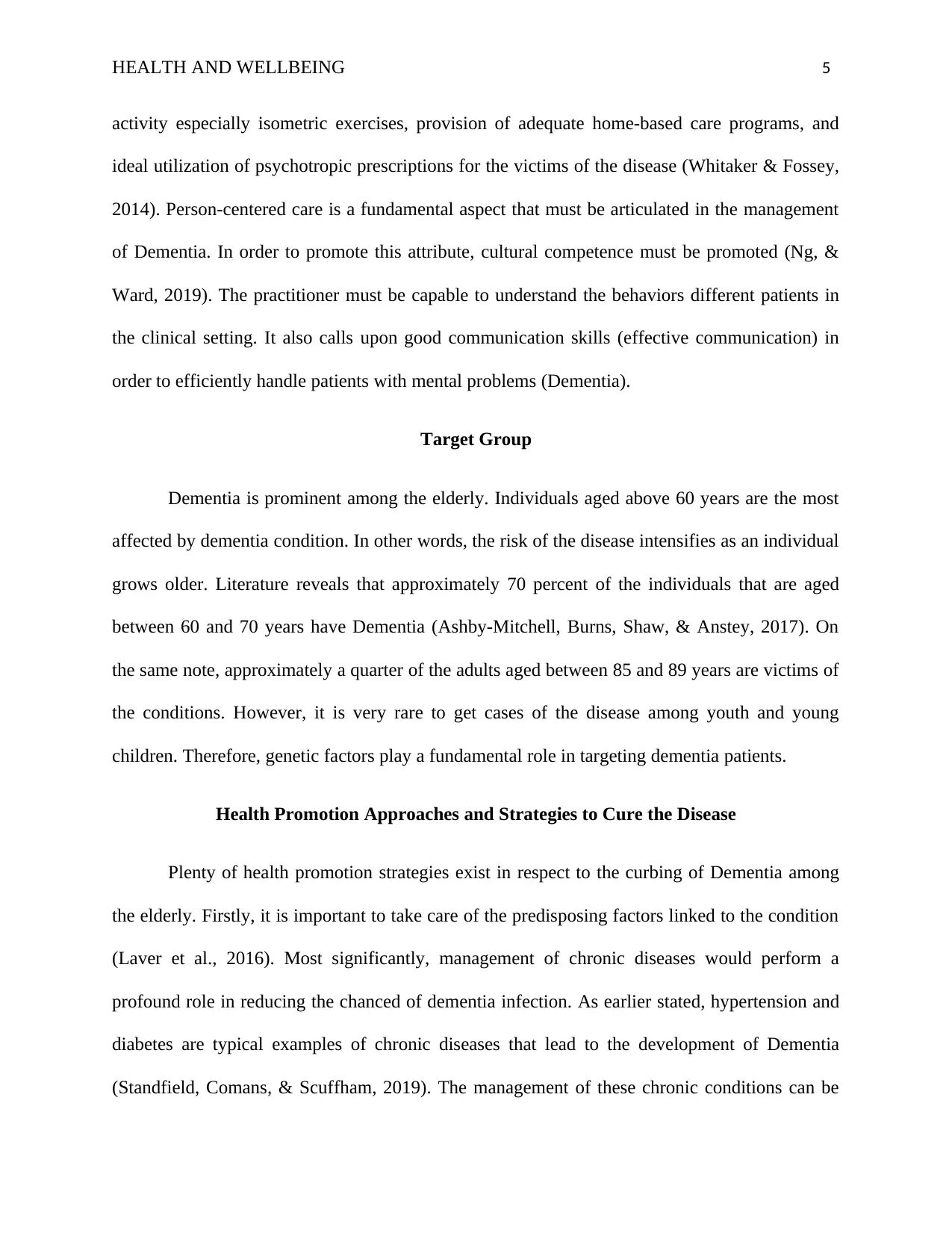
HEALTH AND WELLBEING 5
activity especially isometric exercises, provision of adequate home-based care programs, and
ideal utilization of psychotropic prescriptions for the victims of the disease (Whitaker & Fossey,
2014). Person-centered care is a fundamental aspect that must be articulated in the management
of Dementia. In order to promote this attribute, cultural competence must be promoted (Ng, &
Ward, 2019). The practitioner must be capable to understand the behaviors different patients in
the clinical setting. It also calls upon good communication skills (effective communication) in
order to efficiently handle patients with mental problems (Dementia).
Target Group
Dementia is prominent among the elderly. Individuals aged above 60 years are the most
affected by dementia condition. In other words, the risk of the disease intensifies as an individual
grows older. Literature reveals that approximately 70 percent of the individuals that are aged
between 60 and 70 years have Dementia (Ashby-Mitchell, Burns, Shaw, & Anstey, 2017). On
the same note, approximately a quarter of the adults aged between 85 and 89 years are victims of
the conditions. However, it is very rare to get cases of the disease among youth and young
children. Therefore, genetic factors play a fundamental role in targeting dementia patients.
Health Promotion Approaches and Strategies to Cure the Disease
Plenty of health promotion strategies exist in respect to the curbing of Dementia among
the elderly. Firstly, it is important to take care of the predisposing factors linked to the condition
(Laver et al., 2016). Most significantly, management of chronic diseases would perform a
profound role in reducing the chanced of dementia infection. As earlier stated, hypertension and
diabetes are typical examples of chronic diseases that lead to the development of Dementia
(Standfield, Comans, & Scuffham, 2019). The management of these chronic conditions can be
activity especially isometric exercises, provision of adequate home-based care programs, and
ideal utilization of psychotropic prescriptions for the victims of the disease (Whitaker & Fossey,
2014). Person-centered care is a fundamental aspect that must be articulated in the management
of Dementia. In order to promote this attribute, cultural competence must be promoted (Ng, &
Ward, 2019). The practitioner must be capable to understand the behaviors different patients in
the clinical setting. It also calls upon good communication skills (effective communication) in
order to efficiently handle patients with mental problems (Dementia).
Target Group
Dementia is prominent among the elderly. Individuals aged above 60 years are the most
affected by dementia condition. In other words, the risk of the disease intensifies as an individual
grows older. Literature reveals that approximately 70 percent of the individuals that are aged
between 60 and 70 years have Dementia (Ashby-Mitchell, Burns, Shaw, & Anstey, 2017). On
the same note, approximately a quarter of the adults aged between 85 and 89 years are victims of
the conditions. However, it is very rare to get cases of the disease among youth and young
children. Therefore, genetic factors play a fundamental role in targeting dementia patients.
Health Promotion Approaches and Strategies to Cure the Disease
Plenty of health promotion strategies exist in respect to the curbing of Dementia among
the elderly. Firstly, it is important to take care of the predisposing factors linked to the condition
(Laver et al., 2016). Most significantly, management of chronic diseases would perform a
profound role in reducing the chanced of dementia infection. As earlier stated, hypertension and
diabetes are typical examples of chronic diseases that lead to the development of Dementia
(Standfield, Comans, & Scuffham, 2019). The management of these chronic conditions can be
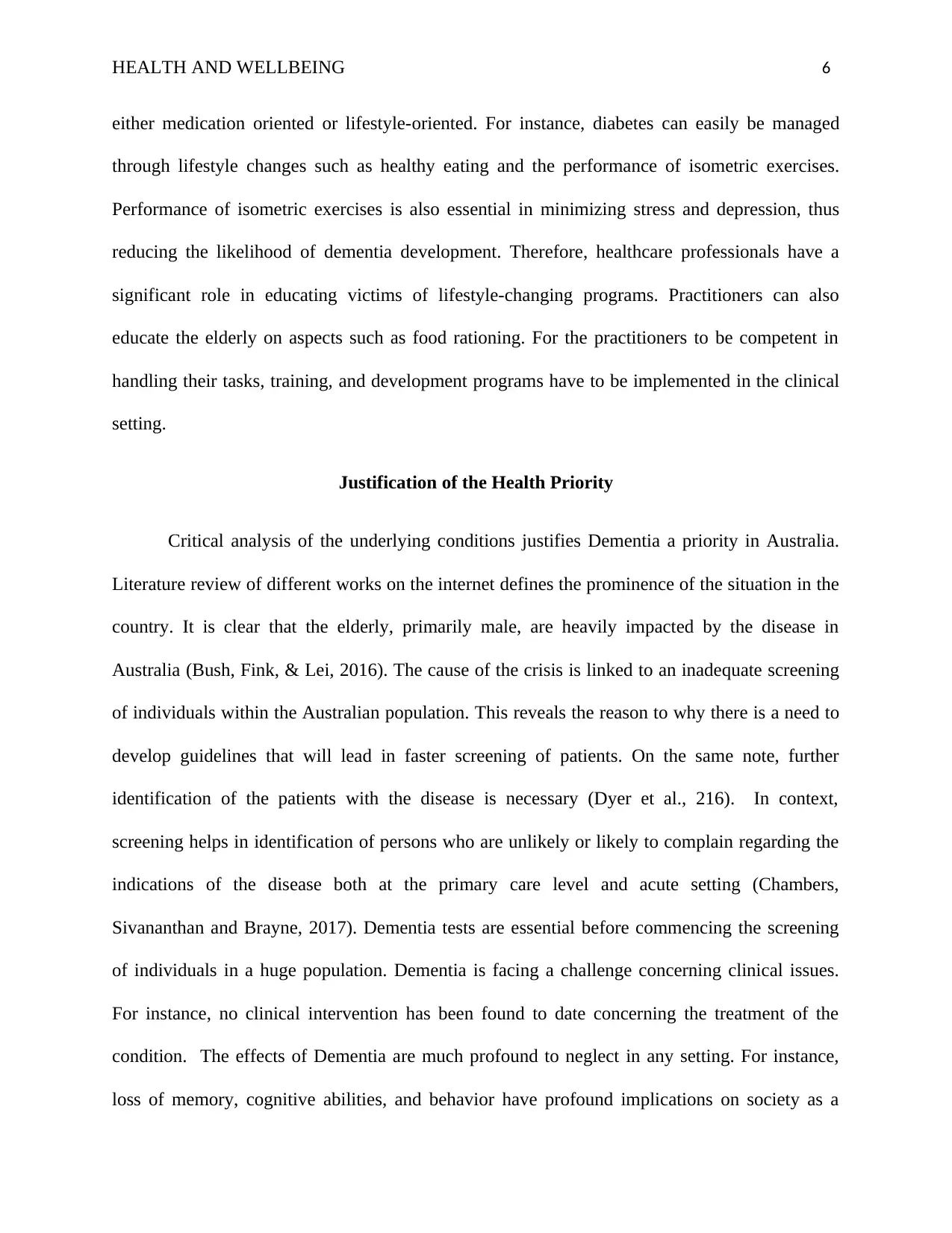
HEALTH AND WELLBEING 6
either medication oriented or lifestyle-oriented. For instance, diabetes can easily be managed
through lifestyle changes such as healthy eating and the performance of isometric exercises.
Performance of isometric exercises is also essential in minimizing stress and depression, thus
reducing the likelihood of dementia development. Therefore, healthcare professionals have a
significant role in educating victims of lifestyle-changing programs. Practitioners can also
educate the elderly on aspects such as food rationing. For the practitioners to be competent in
handling their tasks, training, and development programs have to be implemented in the clinical
setting.
Justification of the Health Priority
Critical analysis of the underlying conditions justifies Dementia a priority in Australia.
Literature review of different works on the internet defines the prominence of the situation in the
country. It is clear that the elderly, primarily male, are heavily impacted by the disease in
Australia (Bush, Fink, & Lei, 2016). The cause of the crisis is linked to an inadequate screening
of individuals within the Australian population. This reveals the reason to why there is a need to
develop guidelines that will lead in faster screening of patients. On the same note, further
identification of the patients with the disease is necessary (Dyer et al., 216). In context,
screening helps in identification of persons who are unlikely or likely to complain regarding the
indications of the disease both at the primary care level and acute setting (Chambers,
Sivananthan and Brayne, 2017). Dementia tests are essential before commencing the screening
of individuals in a huge population. Dementia is facing a challenge concerning clinical issues.
For instance, no clinical intervention has been found to date concerning the treatment of the
condition. The effects of Dementia are much profound to neglect in any setting. For instance,
loss of memory, cognitive abilities, and behavior have profound implications on society as a
either medication oriented or lifestyle-oriented. For instance, diabetes can easily be managed
through lifestyle changes such as healthy eating and the performance of isometric exercises.
Performance of isometric exercises is also essential in minimizing stress and depression, thus
reducing the likelihood of dementia development. Therefore, healthcare professionals have a
significant role in educating victims of lifestyle-changing programs. Practitioners can also
educate the elderly on aspects such as food rationing. For the practitioners to be competent in
handling their tasks, training, and development programs have to be implemented in the clinical
setting.
Justification of the Health Priority
Critical analysis of the underlying conditions justifies Dementia a priority in Australia.
Literature review of different works on the internet defines the prominence of the situation in the
country. It is clear that the elderly, primarily male, are heavily impacted by the disease in
Australia (Bush, Fink, & Lei, 2016). The cause of the crisis is linked to an inadequate screening
of individuals within the Australian population. This reveals the reason to why there is a need to
develop guidelines that will lead in faster screening of patients. On the same note, further
identification of the patients with the disease is necessary (Dyer et al., 216). In context,
screening helps in identification of persons who are unlikely or likely to complain regarding the
indications of the disease both at the primary care level and acute setting (Chambers,
Sivananthan and Brayne, 2017). Dementia tests are essential before commencing the screening
of individuals in a huge population. Dementia is facing a challenge concerning clinical issues.
For instance, no clinical intervention has been found to date concerning the treatment of the
condition. The effects of Dementia are much profound to neglect in any setting. For instance,
loss of memory, cognitive abilities, and behavior have profound implications on society as a
⊘ This is a preview!⊘
Do you want full access?
Subscribe today to unlock all pages.

Trusted by 1+ million students worldwide
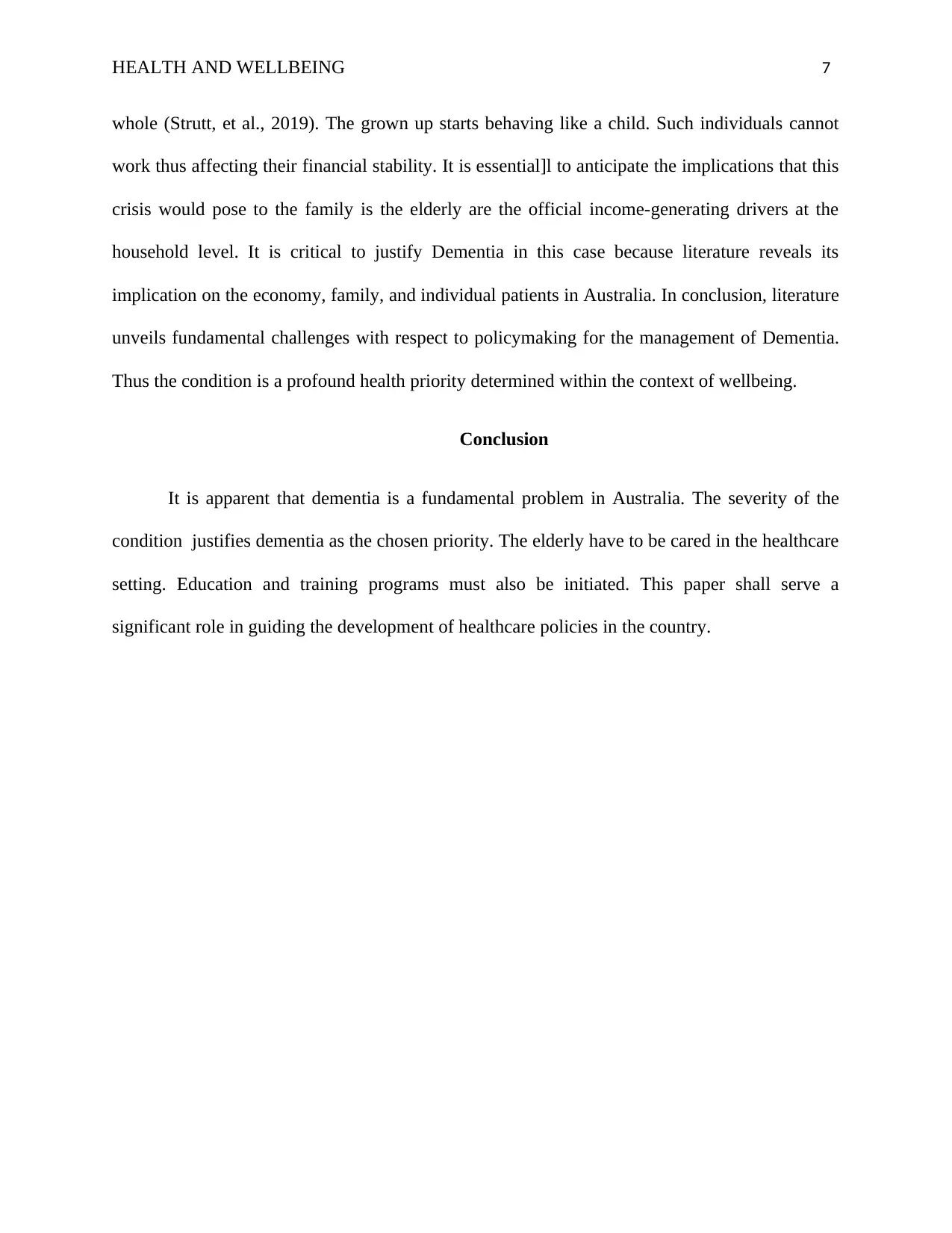
HEALTH AND WELLBEING 7
whole (Strutt, et al., 2019). The grown up starts behaving like a child. Such individuals cannot
work thus affecting their financial stability. It is essential]l to anticipate the implications that this
crisis would pose to the family is the elderly are the official income-generating drivers at the
household level. It is critical to justify Dementia in this case because literature reveals its
implication on the economy, family, and individual patients in Australia. In conclusion, literature
unveils fundamental challenges with respect to policymaking for the management of Dementia.
Thus the condition is a profound health priority determined within the context of wellbeing.
Conclusion
It is apparent that dementia is a fundamental problem in Australia. The severity of the
condition justifies dementia as the chosen priority. The elderly have to be cared in the healthcare
setting. Education and training programs must also be initiated. This paper shall serve a
significant role in guiding the development of healthcare policies in the country.
whole (Strutt, et al., 2019). The grown up starts behaving like a child. Such individuals cannot
work thus affecting their financial stability. It is essential]l to anticipate the implications that this
crisis would pose to the family is the elderly are the official income-generating drivers at the
household level. It is critical to justify Dementia in this case because literature reveals its
implication on the economy, family, and individual patients in Australia. In conclusion, literature
unveils fundamental challenges with respect to policymaking for the management of Dementia.
Thus the condition is a profound health priority determined within the context of wellbeing.
Conclusion
It is apparent that dementia is a fundamental problem in Australia. The severity of the
condition justifies dementia as the chosen priority. The elderly have to be cared in the healthcare
setting. Education and training programs must also be initiated. This paper shall serve a
significant role in guiding the development of healthcare policies in the country.
Paraphrase This Document
Need a fresh take? Get an instant paraphrase of this document with our AI Paraphraser
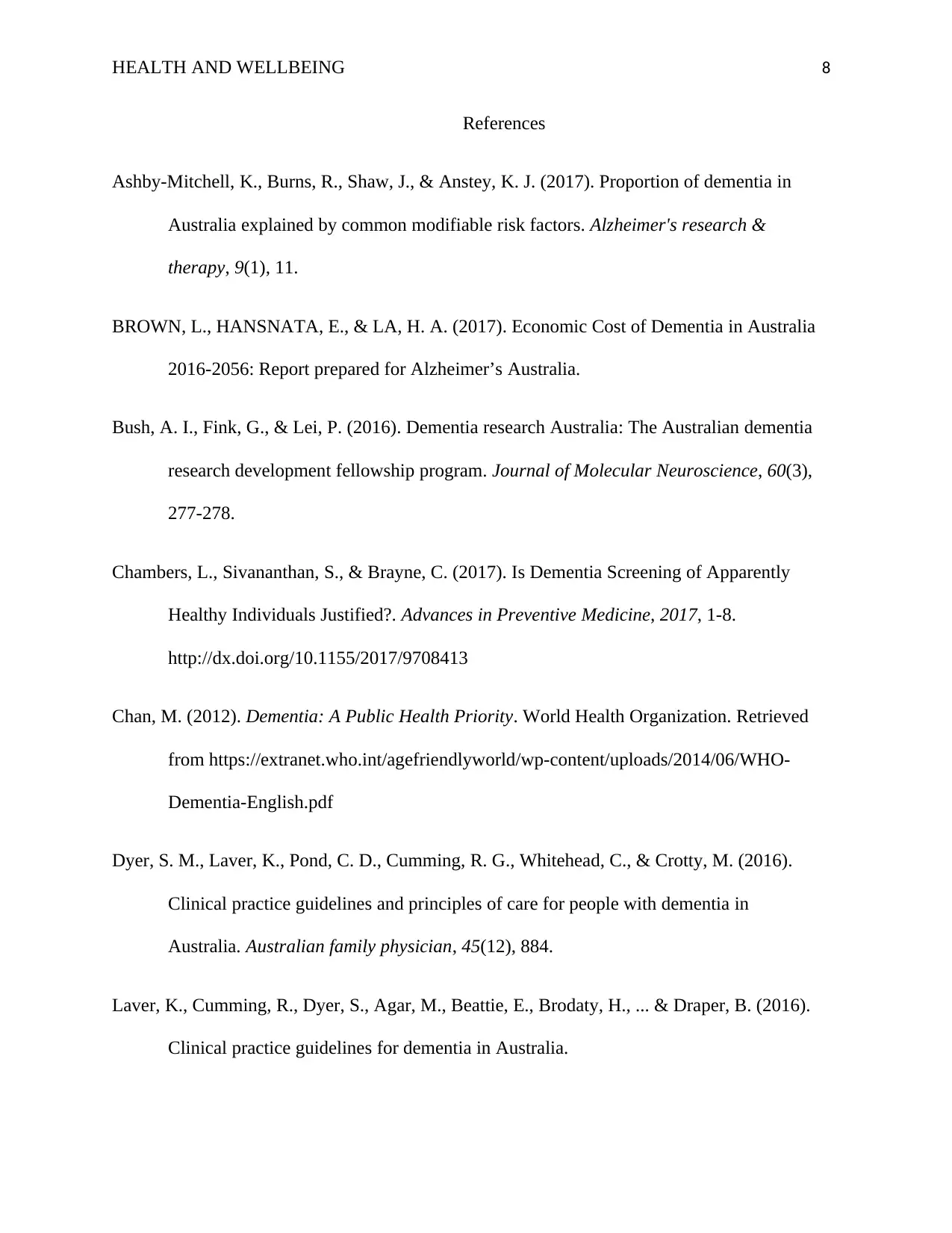
HEALTH AND WELLBEING 8
References
Ashby-Mitchell, K., Burns, R., Shaw, J., & Anstey, K. J. (2017). Proportion of dementia in
Australia explained by common modifiable risk factors. Alzheimer's research &
therapy, 9(1), 11.
BROWN, L., HANSNATA, E., & LA, H. A. (2017). Economic Cost of Dementia in Australia
2016-2056: Report prepared for Alzheimer’s Australia.
Bush, A. I., Fink, G., & Lei, P. (2016). Dementia research Australia: The Australian dementia
research development fellowship program. Journal of Molecular Neuroscience, 60(3),
277-278.
Chambers, L., Sivananthan, S., & Brayne, C. (2017). Is Dementia Screening of Apparently
Healthy Individuals Justified?. Advances in Preventive Medicine, 2017, 1-8.
http://dx.doi.org/10.1155/2017/9708413
Chan, M. (2012). Dementia: A Public Health Priority. World Health Organization. Retrieved
from https://extranet.who.int/agefriendlyworld/wp-content/uploads/2014/06/WHO-
Dementia-English.pdf
Dyer, S. M., Laver, K., Pond, C. D., Cumming, R. G., Whitehead, C., & Crotty, M. (2016).
Clinical practice guidelines and principles of care for people with dementia in
Australia. Australian family physician, 45(12), 884.
Laver, K., Cumming, R., Dyer, S., Agar, M., Beattie, E., Brodaty, H., ... & Draper, B. (2016).
Clinical practice guidelines for dementia in Australia.
References
Ashby-Mitchell, K., Burns, R., Shaw, J., & Anstey, K. J. (2017). Proportion of dementia in
Australia explained by common modifiable risk factors. Alzheimer's research &
therapy, 9(1), 11.
BROWN, L., HANSNATA, E., & LA, H. A. (2017). Economic Cost of Dementia in Australia
2016-2056: Report prepared for Alzheimer’s Australia.
Bush, A. I., Fink, G., & Lei, P. (2016). Dementia research Australia: The Australian dementia
research development fellowship program. Journal of Molecular Neuroscience, 60(3),
277-278.
Chambers, L., Sivananthan, S., & Brayne, C. (2017). Is Dementia Screening of Apparently
Healthy Individuals Justified?. Advances in Preventive Medicine, 2017, 1-8.
http://dx.doi.org/10.1155/2017/9708413
Chan, M. (2012). Dementia: A Public Health Priority. World Health Organization. Retrieved
from https://extranet.who.int/agefriendlyworld/wp-content/uploads/2014/06/WHO-
Dementia-English.pdf
Dyer, S. M., Laver, K., Pond, C. D., Cumming, R. G., Whitehead, C., & Crotty, M. (2016).
Clinical practice guidelines and principles of care for people with dementia in
Australia. Australian family physician, 45(12), 884.
Laver, K., Cumming, R., Dyer, S., Agar, M., Beattie, E., Brodaty, H., ... & Draper, B. (2016).
Clinical practice guidelines for dementia in Australia.
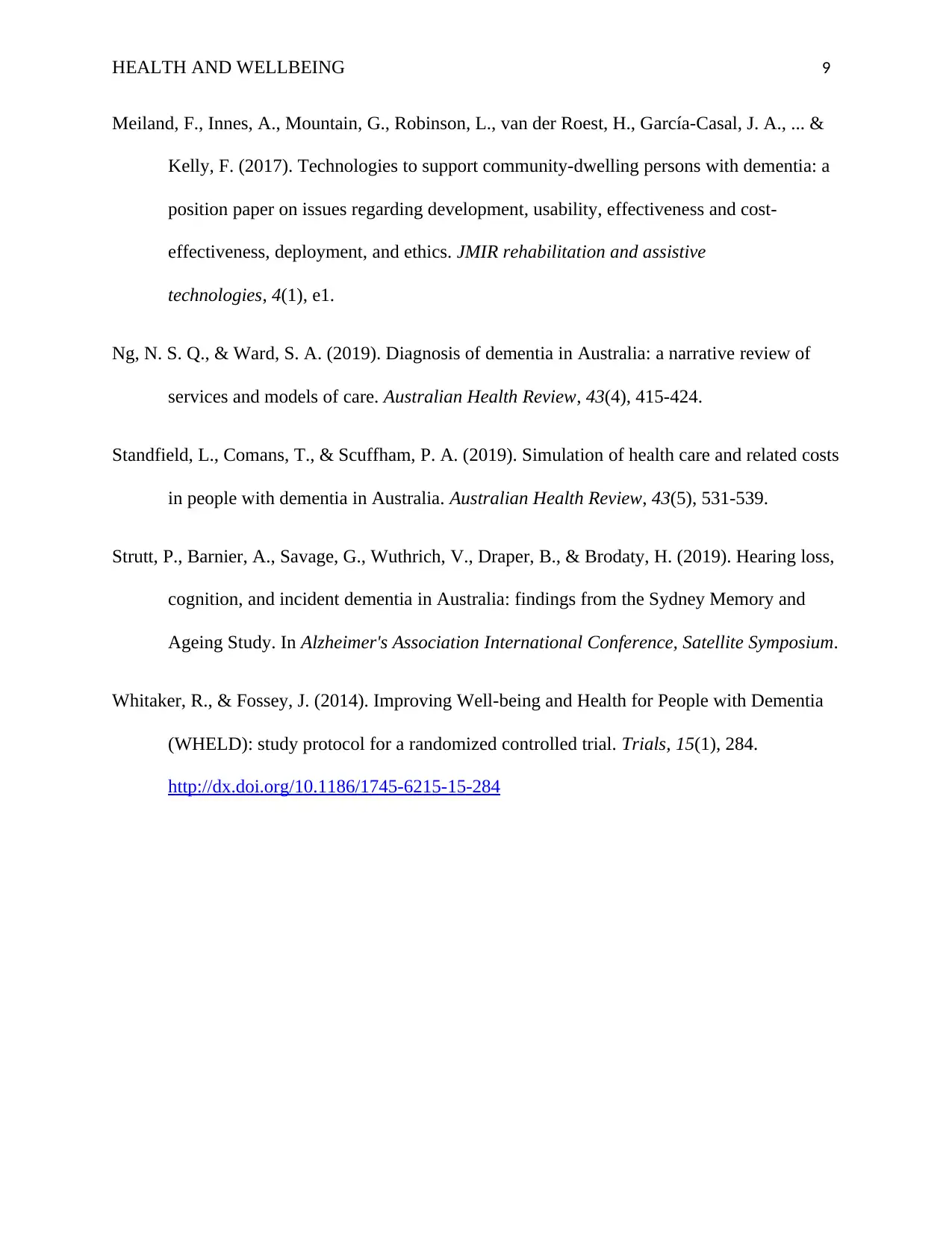
HEALTH AND WELLBEING 9
Meiland, F., Innes, A., Mountain, G., Robinson, L., van der Roest, H., García-Casal, J. A., ... &
Kelly, F. (2017). Technologies to support community-dwelling persons with dementia: a
position paper on issues regarding development, usability, effectiveness and cost-
effectiveness, deployment, and ethics. JMIR rehabilitation and assistive
technologies, 4(1), e1.
Ng, N. S. Q., & Ward, S. A. (2019). Diagnosis of dementia in Australia: a narrative review of
services and models of care. Australian Health Review, 43(4), 415-424.
Standfield, L., Comans, T., & Scuffham, P. A. (2019). Simulation of health care and related costs
in people with dementia in Australia. Australian Health Review, 43(5), 531-539.
Strutt, P., Barnier, A., Savage, G., Wuthrich, V., Draper, B., & Brodaty, H. (2019). Hearing loss,
cognition, and incident dementia in Australia: findings from the Sydney Memory and
Ageing Study. In Alzheimer's Association International Conference, Satellite Symposium.
Whitaker, R., & Fossey, J. (2014). Improving Well-being and Health for People with Dementia
(WHELD): study protocol for a randomized controlled trial. Trials, 15(1), 284.
http://dx.doi.org/10.1186/1745-6215-15-284
Meiland, F., Innes, A., Mountain, G., Robinson, L., van der Roest, H., García-Casal, J. A., ... &
Kelly, F. (2017). Technologies to support community-dwelling persons with dementia: a
position paper on issues regarding development, usability, effectiveness and cost-
effectiveness, deployment, and ethics. JMIR rehabilitation and assistive
technologies, 4(1), e1.
Ng, N. S. Q., & Ward, S. A. (2019). Diagnosis of dementia in Australia: a narrative review of
services and models of care. Australian Health Review, 43(4), 415-424.
Standfield, L., Comans, T., & Scuffham, P. A. (2019). Simulation of health care and related costs
in people with dementia in Australia. Australian Health Review, 43(5), 531-539.
Strutt, P., Barnier, A., Savage, G., Wuthrich, V., Draper, B., & Brodaty, H. (2019). Hearing loss,
cognition, and incident dementia in Australia: findings from the Sydney Memory and
Ageing Study. In Alzheimer's Association International Conference, Satellite Symposium.
Whitaker, R., & Fossey, J. (2014). Improving Well-being and Health for People with Dementia
(WHELD): study protocol for a randomized controlled trial. Trials, 15(1), 284.
http://dx.doi.org/10.1186/1745-6215-15-284
⊘ This is a preview!⊘
Do you want full access?
Subscribe today to unlock all pages.

Trusted by 1+ million students worldwide
1 out of 9
Related Documents
Your All-in-One AI-Powered Toolkit for Academic Success.
+13062052269
info@desklib.com
Available 24*7 on WhatsApp / Email
![[object Object]](/_next/static/media/star-bottom.7253800d.svg)
Unlock your academic potential
Copyright © 2020–2025 A2Z Services. All Rights Reserved. Developed and managed by ZUCOL.




